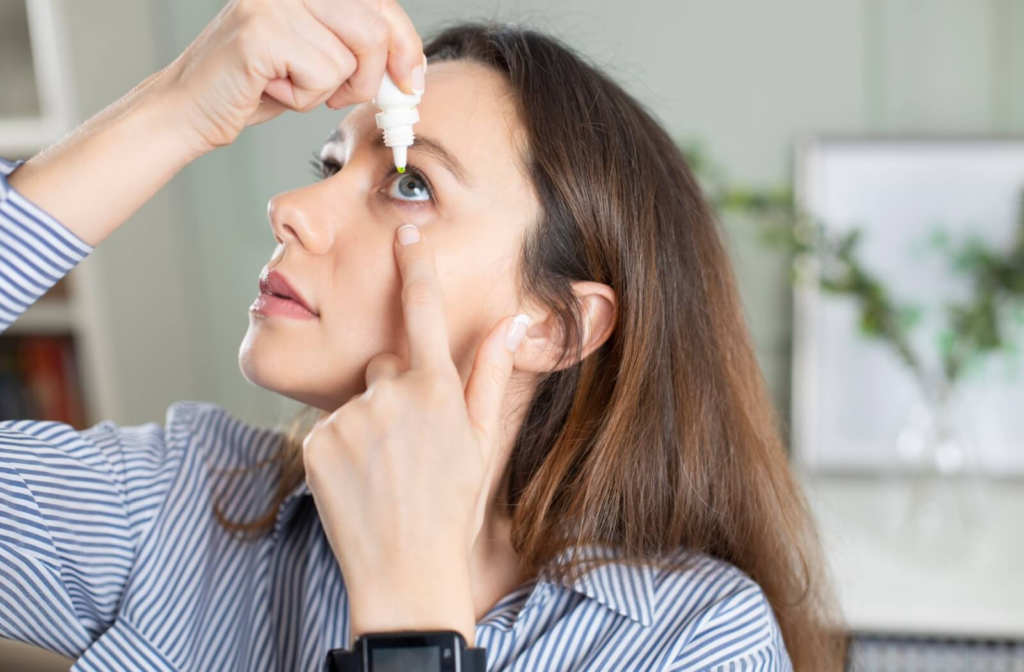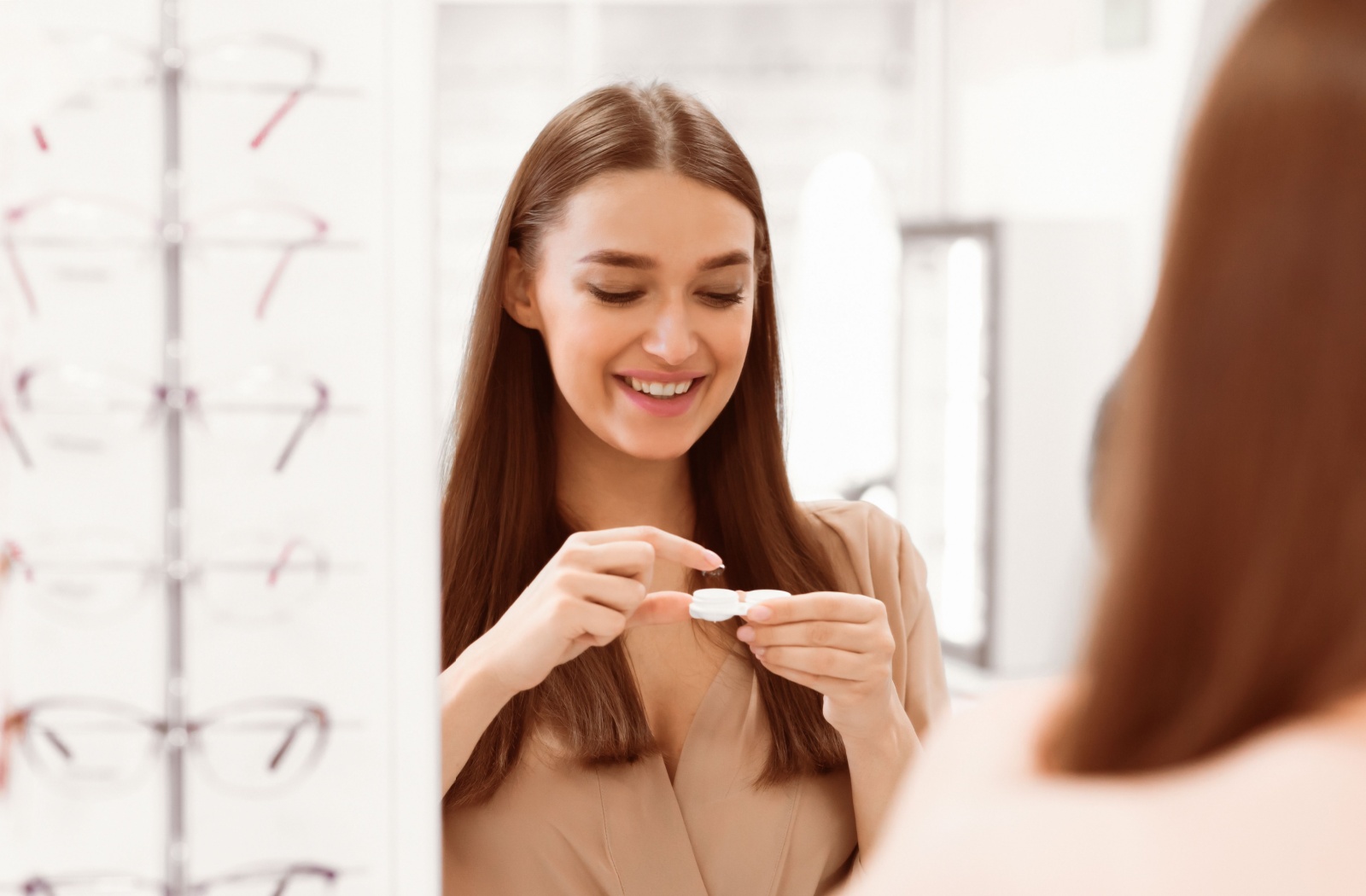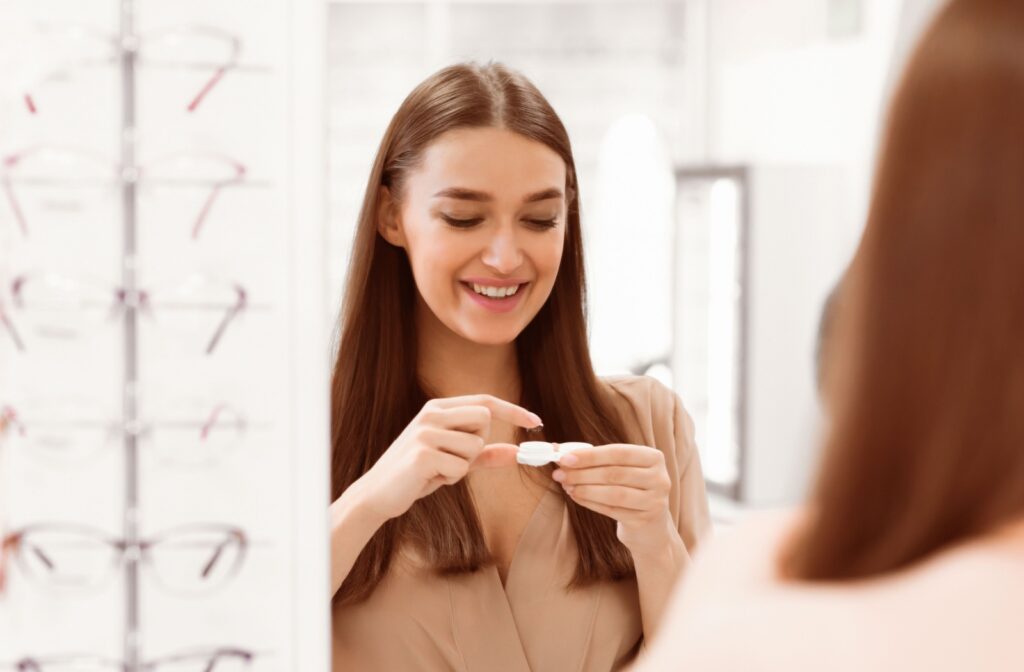Wearing contact lenses can be a convenient and comfortable way to correct your vision—until dryness, irritation, or allergies start to interfere. Many contact lens wearers experience occasional discomfort, especially in dry environments or during allergy season. In these moments, eye drops can feel like a quick fix for relief.
You can use eye drops while wearing contacts, but not all eye drops are created equal. Only certain formulations are safe to use with lenses in, and choosing the wrong kind can cause irritation or affect your lenses.
From managing digital eye strain to allergies or general discomfort, it’s important to use drops designed specifically for contact lens wearers.
How Eye Drops Support Your Eye Health
Eye drops are liquid solutions designed to be applied directly to the surface of your eyes. They serve a range of purposes—from providing moisture and comfort to delivering medication that supports your eye health.
Some eye drops mimic the composition of natural tears, offering relief from dryness or irritation. Others may contain ingredients like antihistamines to reduce allergy symptoms, or medications to treat specific conditions such as infections or glaucoma.
Whether over-the-counter or prescription, eye drops allow active ingredients to reach the eye quickly, offering fast or long-lasting relief depending on the formulation.
Types of Eye Drops
There are several types of eye drops, each designed to support different eye care needs:
- Lubricating eye drops (artificial tears): Help relieve dry, irritated eyes
- Allergy eye drops: Target symptoms like itching, burning, or redness caused by allergens
- Anti-redness drops: Reduce the appearance of bloodshot eyes by narrowing blood vessels
- Prescription or medicated drops: Used to manage conditions such as glaucoma, infections, or inflammation
Before using any eye drops, it is essential to book an eye exam so we can recommend drops suited to your lifestyle and needs.
Using Eye Drops With Contacts
There are several reasons you might use eye drops while wearing contact lenses, especially if you experience discomfort, dryness, or irritation throughout the day.
Dry Eye Relief
Contact lenses can sometimes worsen dry eye symptoms, making it harder to wear them comfortably for long periods. Lubricating eye drops—often called rewetting drops—can help restore moisture to the eye’s surface, easing dryness and enhancing comfort.
Lens Hydration
Keeping your contact lenses hydrated is important for maintaining clear vision and reducing irritation. Eye drops made specifically for contact lens wearers help keep lenses moist, which can minimize blurry vision and reduce the risk of dryness-related discomfort.
Enhanced Comfort
Wearing contacts for extended hours can lead to tired, irritated eyes. Rewetting drops provide a layer of hydration and lubrication, helping your lenses feel more comfortable from morning to night.
Safe Eye Drops For Contacts
Not all eye drops are safe to use while wearing contact lenses. Some require you to remove your lenses before application, while others are formulated specifically for use with contacts.
Ingredients to Avoid
Certain preservatives and chemicals can interact with contact lenses or irritate your eyes. Look out for ingredients like benzalkonium chloride (BAK) and thimerosal, which may cause discomfort or damage to your lenses with repeated use.
Contact Lens-Compatible Ingredients
Choose eye drops clearly labeled as safe for contact lens use. These formulations are often preservative-free or contain contact lens-safe preservatives and are designed to be gentle on both your eyes and lenses. Common safe ingredients include sodium hyaluronate and polyethylene glycol, which help maintain moisture without interfering with your lenses.

Safe Use Of Eye Drops & Contacts
If you wear contact lenses, it’s important to use eye drops correctly to protect both your eyes and your lenses. Here are a few key guidelines to follow.
Proper Application
Using eye drops while wearing contact lenses is simple but requires attention to hygiene and technique:
- Wash your hands thoroughly to avoid transferring dirt or bacteria to your eyes.
- Tilt your head back slightly, gently pull down your lower eyelid, and apply 1 or 2 drops as directed.
- Blink a few times to help distribute the drops evenly across the eye’s surface.
- Repeat in the other eye, and always follow the instructions provided by us or the product manufacturer.
Hygiene Practices
Maintaining good hygiene is essential when using eye drops with contacts:
- Avoid touching the dropper tip to your eye, fingers, or any surface to prevent contamination.
- Store eye drops in a cool, dry place.
- Discard the bottle after the recommended period—typically 30 days after opening.
Frequency of Use
Always follow the recommended usage instructions on the product label. Overusing eye drops can sometimes lead to rebound symptoms or dependency. If you’re unsure how often to use your drops—or if symptoms persist—contact our team for guidance tailored to your needs.
What To Remember About Eye Drops & Contacts
Using eye drops with contact lenses can be safe and effective when you choose the right kind and use them properly. Whether you’re managing dry eye, allergies, or just looking for a little added comfort, the key is using drops specifically designed for contact lens wearers.
If you’re unsure which product is right for you, our team at Dr. Jennifer L. Shane & Associates is here to help. We’ll assess your eye health, review your contact lens routine, and recommend a solution tailored for your needs. Book your appointment today and get guidance for clearer, more comfortable vision.



